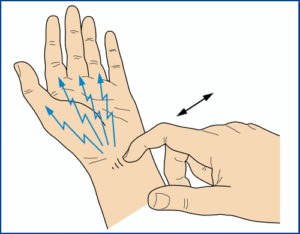TINEL’S TEST

What’s Tinel’s test?
Tinel’s test refers to a procedure used to test for compression neuropathy, commonly in diagnosing carpal tunnel syndrome.
Tinel’s sign refers to a tingling or “pins and needles” feeling one gets when the healthcare provider taps the skin over a nerve. Tinel’s sign might serve as an indicator that one may have nerve compression or damage around the tapped area. The healthcare provider may carry out Tinel’s test if concerns arise about nerve damage or irritation at a specific site.
Does Tinel’s sign have another name?
The healthcare provider may refer to this sign as Tinel’s sign or Hoffmann-Tinel sign. The names come from people who first described it in 1915, physiologist Paul Hoffmann and neurologist Jules Tinel.
Technique
Specialists perform this test by lightly tapping (percussing) over the nerve to elicit a sensation of tingling or “pins and needles” in the distribution of the nerve. The Tinel sign includes the tingling or prickling sensation elicited by the percussion of an injured nerve trunk at or distal to the site of the lesion. The sign also indicates nerve regeneration.
Positive test: The test proves positive when the patient experiences a tingling or prickling sensation in the distribution of the nerve.
What does a positive result mean?
A positive result means that the tapped nerve experience recurrent compression by nearby tissue. Such nerve compression can occur due to many things, including:
- An injury
- Arthritis
- Stress from repetitive movements
- Obesity
What does a normal result mean?
If one does not feel a tingling sensation when the doctor taps on the nerve, this usually denotes a normal result. The patient must keep in mind that a compressed nerve might still occur even with a normal Tinel’s sign test result. The doctor may choose to do some additional testing, especially if the patient has any one of the following symptoms near the nerve:
- Numbness
- Muscle weakness (hypotonia)
- Sharp, radiating pain, aching, or burning sensation
- Frequent “pins and needles” sensatio
Conditions associated with a positive Tinel’s sign
- Carpal Tunnel syndrome
- Cubital tunnel syndrome
- Radial nerve entrapment
- Tarsal tunnel syndrome
- Superficial peroneal neuropathy
- Thoracic outlet syndrome
Applications of Tinel’s test
Some examples of when a healthcare provider might carry out Tinel’s test include:
- Carpal tunnel syndrome: In carpal tunnel syndrome, pressure on the median nerve at the wrist causes symptoms in the hand and fingers.
- Cubital tunnel syndrome: In cubital tunnel syndrome, damage to the ulnar nerve (sometimes referred to as the funny bone) in the elbow causes symptoms in the hand and fingers.
- Tarsal tunnel syndrome: In tarsal tunnel syndrome, the posterior tibial nerve gets compressed as it travels along the internal aspect of the ankle. This can cause pain, tingling or numbness in the foot.
The Accuracy of a Tinel’s test?
Certain debates persist within the medical community about the effectiveness of testing for Tinel’s sign.
A recent study of 100 people with carpal tunnel syndrome found that only 25 percent of participants had a positive result for Tinel’s sign. However, another study of 50 people with carpal tunnel syndrome found that 72 percent of these individuals had a positive result for Tinel’s sign.
As a result, the doctor may likely use some additional test to confirm the compression of a nerve. These might include:
This involves resting the flexed elbows on a table and allowing the wrists to fall freely into a flexed position. The patient may hold this position for at least one minute. In carpal tunnel syndrome, the patient may experience tingling or numbness in the fingers within a minute.
- X-rays
If the patient has a limited range of motion associated with other symptoms, the doctor may order an X-ray to check for signs of injury or arthritis.
- Nerve conduction velocity test
This test helps the doctor evaluate how well the nerves function. It stimulates several areas along the affected nerve using electrodes in the skin. It measures the speed of the nerve and determines if any area of slow impulse transmission occurs. This can demonstrate the location of the block and the severity of the problem.
